Samothrace: Walking on the Wild Side
By Dalia Miller
"Wait a minute, where exactly are we? Is this a "Greek" island?" ask tourists who have been acculturated on trendy Mykonos or Santorini.
Most travelers
arrive in Samothrace expecting white cubic houses dazzling in the sun
and upscale hotels and restaurants catering to international tastes. What
they encounter is something else. A sleepy backwater tucked into the northeast
corner of the country, the island seems strange and unfamiliar, a dark
mass of granite rising vertically from the sea. Tourism in these parts
is still in its infancy, and Samothrace's luxuriant forests and earthy
simplicity a well kept secret. Locals call the region the step-child of
Greece since so little of the country's largesse trickles down to benefit
them. Forgotten and isolated, this Greece of yesteryear quietly awaits
discovery…
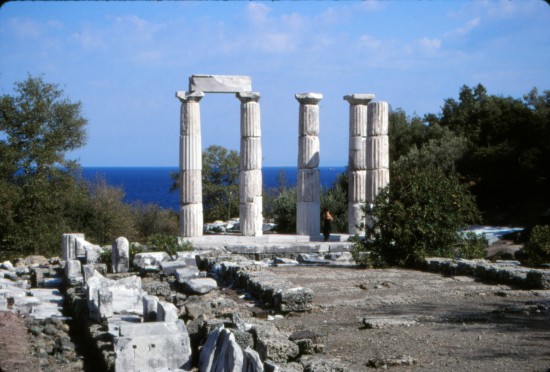
The Hieron at the Sanctuary of the Gods
Knowing all this, our party of five boards the early ferry from Alexandroupolis
with both apprehension and a sense of adventure. Jostling deck space with
a few Scandinavian and German families, we cross the turbulent Northern
Aegean in just under three hours. Even from afar we are struck by the
island's imposing physicality: Mount Fengari (moon mountain), at 5,285
feet the tallest body of land in the Aegean, looms ahead, its head literally
in the clouds. Atop the summit, Homer tells us, Poseidon sat and watched
the siege of Troy.
Near the
sea in a stony ravine lies the Sanctuary of the Great Gods (Hieron Ton
Megalon Theon) where mysterious rites dating from the pre-Greek era were
performed. Philip of Macedon journeyed here and fell in love with Epirote
princess Olympias who soon became his wife and mother of Alexander the
Great. Here also came Herodotus, whose writings left the world some clues
about its mysteries, as well as the infamous admiral Lysander of Sparta.
Even Plato, Aristophanes and Emperor Hadrian were among a long list of
illustrious initiates. The occult ceremonies practiced here were popular
throughout the Eastern Mediterranean for more than 1,000 years, finally
fading into obscurity when Rome adopted Christianity.
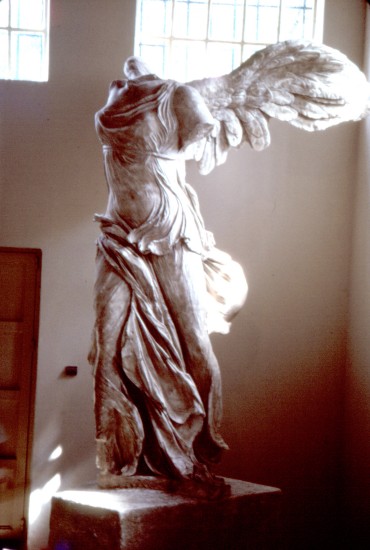
A plaster cast of Nike, the Winged Victory of Samothrace
But more than the sanctuary, the island's greatest claim to fame is the
exquisite Winged Victory of Samothrace, or Nike, once the crown jewel
of the site. In 1863 it was discovered by the French consul and amateur
archaeologist Charles Champoiseau and shipped to Paris where it now dominates
the Daru staircase in the Louvre. We have read that a plaster replica
of Nike is installed in the sanctuary museum not far from the location
of the original and that her "spirit" lingers on the island.
Carved in pure Parian marble, Nike is considered one of the great surviving
masterpieces from the Hellenistic period. So highly was she valued that
in 1939, after World War II broke out, Nike was spirited away to a chateau
for safekeeping lest Göring and other greedy Nazi art collectors
haul it away.
Even from our ferry, the island appears very green and wild. A hiker's nirvana we are sure, worthy of an exploration on foot. Suddenly, Kamariótissa, the colorful small port, appears straight ahead. Numerous fishing caiques bob up and down alongside our ferry berth. We can spot several café bars, tavernas, fish restaurants, a bakery, greengrocers, assorted shops and a cluster of bikes and mopeds waiting for customers. Clearly, Kamariótissa is the island hub for transportation and accommodations, but we opt to drive our car right off the ferry and head to Thermá, a small health resort on the northern coast. Known for its ancient therapeutic springs, this quaint village attracts Greeks and a few foreigners who come for the cure and a chance to hike up numerous trails at the lower slopes of the mountain. Nearby, several campgrounds are popular with younger New Age Greeks and Europeans.
Centuries-old plane trees, part of the largest forest of the species found in Europe, surround the spa. Patrons enveloped in large towels are continuously entering and exiting the building which houses the thermal springs. Some are seated at small tables outside drinking coffee or ouzo, smoking, arguing non-stop about politics, or exchanging a juicy bit of gossip. "Ach! Ti tha yini stin Ellada?" (What will become of Greece?), I overhear one middle-aged housewife sigh resignedly, echoing the sentiment of the rest of her little circle bemoaning Greece's economic decline. How I would love to be a fly on the wall to hear their biting repartee! Deep in the woods, the unpretentious Orpheus Hotel takes our luggage, supplying us with a good map and plenty of advice. We set out immediately to explore.
About six kilometers to the south, on the edge of the sea, lay remnants of Cyclopian walls that surrounded the ancient settlement of Palaiopolis. Adjoining is the Sanctuary, a site built on a grand scale and unlike any other we have ever seen in Greece. "What ancient truths will we discover here? "Where should we begin?" my husband remarks as we climb. A couple ahead of us overhears our comments. "I am Sotirios and this is my wife, Vasso," interjects a genial gray-haired man with a big smile, probably an academic. "We are Canadian, but my family is originally from this island. We come almost every summer to visit. Let us show you around," he insists before we can get a word in edgewise.
Five of us amiably form a line behind our new friends, proceeding first to the Anaktoron. This rectangular structure dating from 600 BC is where the first phase of initiation (the meísis) took place. Our self-appointed guide begins: "Cult worship here originally revolved around ancient Thracian fertility deities: the great mother Axeiros and her consort Kadmilos, as well as the twin demons, the Kabeiroi, protectors of nature and sea travelers." I have read that when the Greeks arrived in the 6th century, the Great Gods became Demeter and Hermes, and the Kabeiroi were associated with the Dioscouroi, Castor and Pollux. "The rites here were made available to "everyone"--men, women, slaves, foreigners, even children," Sotirios emphasizes. I wonder if this inclusivity was the earliest form of democracy to take hold in the Greek world. Vasso continues: "The ceremony was a ritual simulation of the life cycle and was always held at night, illuminated by torches." Their passion for the place is evocative. We can all envision white robed initiates holding up their flames in the moonlight.
They lead us through pink oleanders to the Rotonda of Arsinoe (Arsinoeion), the largest round structure known in ancient Greece, built around 290 BC in honor of the Great Gods by Queen Arsinoe II who married her brother Ptolmey II. "Here," Sotirios waves his arms in the air as he speaks, "at the annual summer festival, many animal sacrifices were made on the great altar in the center of the rotunda surrounded by spellbound celebrants. In the next building, the Temenos, grand banquets were staged."
We approach the impressive Hieron, a large Doric building with five columns and an architrave that have been re-erected by the American School of Classical Studies. It is dazzling against a cobalt blue sky. The second phase of the rituals, the epopteía (viewing) happened here. "Each initiate had to make a total confession first," Sotirios clarifies. He has our undivided attention as he describes the climax of the initiation: "During the Roman Era, those who had confessed descended into a pit at the end of the Hieron. Here, buckets of bull's blood were poured over them, a baptismal ritual of sorts." Vasso explains that at the completion of the rites, each initiate received a purple belt and an iron ring to signify inclusion in the cult. In the ancient world, participation in the mysteries at Samothrace was considered a great accomplishment and the amulets were worn as a badge of honor back in their home towns.
They lead us to a ridge beyond the remains of a theater where Nike, goddess of victory, had been found laying on the ground. She was originally placed in a niche in the theater on the prow of a marble ship, breasting the wind, a votive offering of the Rhodians to commemorate a victory over Antiochus in 190 BC.
As we enter the museum, the guard nods to the couple. I am sure he is used to seeing plenty of tourists squired around by his old friends. The central hall contains architectural restorations from the main buildings of the site. Other rooms hold sculptures, all kinds of pottery, friezes and unusual metal objects. We seek out the dancer's frieze, a delicate entablature that adorned the Hieron. In the last room we find a plaster cast of Nike, wings aloft, as if she has just landed in a fierce headwind. Nike's body is twisted as if she were trying to keep her balance, and her chiton, heavy with sea spray, both clings to her body and billows in the wind. Her arms and head are missing, of course, and somehow that adds to the dramatic effect of the sculpture. The theatricality of the piece is a hallmark of Hellenistic art.
"I hope
you now understand how important this site was for Greeks and for mankind,"
Sotirios emphasizes in parting. How could we not! Sotirios and Vasso have
given us so much insight and information. Each of us shakes their hands
in gratitude. They turn around in a flash, returning to the sanctuary
where new visitors look as if they could use some assistance. How fortunate
that they are willing to act as docents! Were we just lucky, or was it
preordained?
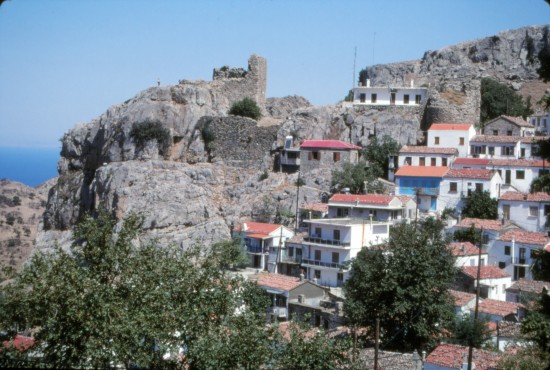
Built into the mountain, Hora is surveilled by the Galliatzi Tower
It is now late afternoon, well past six o'clock. Shadows have elongated
and a golden aura softens the landscape. We drive a few kilometers into
the interior to reach Hora, the capital. Concealed by mountains to elude
pirates who ravaged the island in the medieval period, Hora suddenly bursts
into view straddling a natural amphitheater. Driving in town is restricted,
so we find a parking spot on the outskirts and begin a slow and steady
climb up twisting, cobbled streets. Thracian-styled white stone houses
with red roofs are sited to receive maximum exposure to sunlight. "This
town is magnificent," I blurt out loud, echoing the sentiments of
my companions who tell me that Hora has been officially declared a national
historic settlement, its architectural integrity to be preserved for posterity.
At one end of town, looking out to a wine-dark sea, are the ruins of a
massive Galliatzi tower, a 15th century remnant of the island's Genoese
occupation. It is a popular spot for young lovers who sneak away from
town to steal a kiss or two.
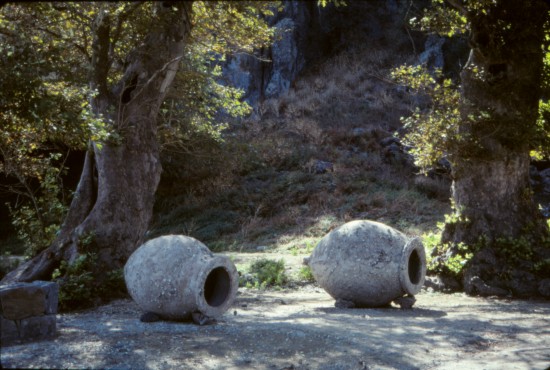
In Thermá, old jugs and massive plane tress with bulbous trunks
Shops are bustling with early evening shoppers. A tiny zaharoplasteíon
(sweet shop) on the first plateía (square) is crowded with families
enjoying a baklava or perhaps or a more Turkish inspired ekmék
kadaïfi (shredded filo with custard and topped with cream), their
dinner still a good three hours away. In the central square a small restaurant
is serving up crepes in a garden setting. Above our heads, a deafening
bell chimes and we are told by the sexton that here in this Church of
the Dormition of the Theotokos are the skulls of five martyred villagers,
victims of a Turkish reprisal in 1836. A panegyri (worship and celebration)
in their honor is held yearly on the Sunday after Easter. How we wish
it were today, for we have read that the islanders love to dance lively
karsilamades (face to face couple dances) and yiar-yiar, a line dance
unique to Samothrace.
The energy in Hora is palpable. To our right, the high school field teems with noisy youths playing a spirited game of soccer. About a dozen squealing toddlers almost crash into us as they run in circles, chased by three dusty dogs, half a dozen skinny cats and assorted parents shrieking loving directives. We marvel at how Greeks have mastered the ability to enjoy the moment in any setting.
Up a few stairs, a private folk museum overlooks the scene. Maria Ververi-Krause, the owner, waves us in and we can tell at a glance that it is very special. "Our town is perífani (proud)," she tells us, beaming. "Our local dímarchos (mayor) has inspired the entire town to work together to preserve our buildings and traditions. Here in this museum you can see examples of our beautiful costumes, cooking utensils, pottery, embroideries and jewelry." She shows us around, chattering non-stop. Maria is a real charmer and one could spend hours with her. She insists we taste one of her delicious kourambiédes (walnut cookies covered in powdered sugar). We appreciate her filoxenía (hospitality) and leave a small donation for the museum in a large bowl.
It is still too early for dinner, so have time to check out Kamariótissa. Several fish restaurants on the waterfront look promising. We stroll up and down the harbor area until the time is right, letting our nostrils guide us. One airy establishment, To Acholiadi, seems to be a cut above the others. The proprietor brings out an assortment of fish on ice. Oh, what to choose? We order mídia saganáki (mussels sautéed with local onions and a hint of hot peppers), complemented by our favorite brand of retsina. Garlic infused sea bream comes to our table next, with a side of crisp fried potatoes and a plateful of lemon halves. I am always astounded by how wonderful potatoes are in Greece. It must be their good olive oil and a locavore tradition: Greeks mostly eat what is grown or raised nearby.
Back in Thermá,
we fall into bed, visions of torch-lit rites inducing a deep, restorative
sleep. In the morning, strong Greek coffee and loukoumádes (fried
puffy doughnuts) dripping with honey are just the right starter for several
hours of exploration on foot. I put on my hiking shoes with non-slip soles
and plenty of bug spray. Water bottles and maps in hand, we head toward
the delta of the Foniás River and a trail that leads to Griá
Váthra, an area of dark pools that are formed by impressive waterfalls.
Foniás means "killer" and the upper reaches of its gorge
can be very dangerous for unskilled climbers. Near the beach, another
Galliatzi fortress marks the beginning of the trail. Hiking along the
riverbed, we find the vegetation to be truly astonishing: arbutus, maples,
myrtles, bush cedars, lush ferns, a medley of wildflowers and nettles,
and everywhere magnificent plane trees with bulbous trunks and exposed
roots. In Samothrace's most remote sections, stands of primeval oak are
remnants of a vast forest that once blanketed the island.

Deep in the forest, ancient trees and huge rocks provide an idyllic rest stop.
We walk silently and take in the sounds and smells around us. Overhead,
birdsong resonates nonstop from nests on upper branches of towering trees.
Cicadas sing and colonies of amber butterflies flit from hydrangea blossoms
to wild roses. Samothrace's animal life is especially rich due to its
remoteness. Here live the last remaining enclaves of monk seals in Greece,
as well as golden eagles and hawks, rare sea turtles and an endangered
species of wild goat. Numerous migrating birds make a stop on the island
on their way north or south, including flocks of storks, usually found
roosting on chimneys and telephone poles on the Thracian mainland. Samothrace
may be undeveloped, but ecotourism has a bright future here.
Out of nowhere,
four Greek teenagers jump into the crystal waters of one of the deep pools.
"Krióno," (I am cold), a curly-haired Adonis complains,
but continues to splash nonetheless. If you look straight up behind them,
a thundering waterfall cascades into the váthra (pool) from the
sheer granite slopes of Mount Saos. I check my guide book and note that
Saos is the ancient name of the mountain, with Fengari specifically denoting
its windswept summit. Islanders believe that on clear nights the wind
at the very top is so fierce that even the moon is blown away. We scoop
up a cup of water. It is ice cold, pure and refreshing. We spread a blanket
under a under a huge plane tree and savor the moment with a few provisions:
crusty bread, local cheese, olives and some early season cherries. What
could be better?
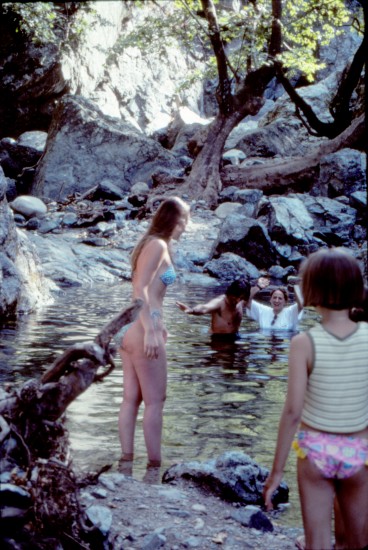
On the Fonias trail, a vathra (pool) is enjoyed by a group of teenagers.
Samothrace continues to reveal itself. On our afternoon drive, we explore
the southern side of the island, where vast fields of silvery olive groves
quiver in the breeze. At the southeast corner the important wetland of
Aghios Andreas attracts seasonal migrations of jays, herons and gulls
alternating with nightingales, finches and cuckoos. Nearby, the newly
installed Aeolian Park boasts four wind generators that harness enough
energy to supply the entire island with power. Primitive it is, but in
some ways Samothrace is more advanced than many countries.
A few kilometers away, Pachia Ammos is the finest beach on the island with thick sand bordered by rocky promontories that jut out to the sea. From here we make a short journey by caique to the wild coastline of the eastern side where steep cliffs plunge without warning to a deep sea and massive rocks appear surreal, sculpted through the ages by salt and wind. Above, a small church hangs precariously on a precipice. Vatos, another sandy beach, is surrounded by huge rocks with caves. Just beyond, the Kremastos waterfall empties directly into the sea, an unbelievable sight! We turn to the east. In the haze we can make out Imvros, formerly a Greek island, but now part of Turkey.
The sea journey
whets our appetites. In the rustic village of Lakoma, half a dozen pantalooned
old men resting under overhanging roofs wave with smiles and curiosity
as we drive cautiously through the only road for vehicles. Higher up in
Profitis Ilias, Taverna Vrachos has been recommended for its specialty:
young island goat (katsikáki), hand-rubbed with aromatic herbs
and spit roasted over coals. It is early but we are ready to experience
our first goat barbecue. Plates of horta (steamed greens), and lemon roasted
potatoes accompany the succulent meat. It is a soul satisfying dish. Apostolos,
the owner, seems very pleased that we have enjoyed the meal. He asks if
in Chicago (the only city he is familiar with in the U.S.) the goats are
as tasty as here. "Poté," (never), we assure him, "our
cooking does not even come close." He beams and tells us that Samothrace
has a population of 100,000 goats, about 33 for every island resident.
We drive away with several old goat bells purchased as souvenirs.
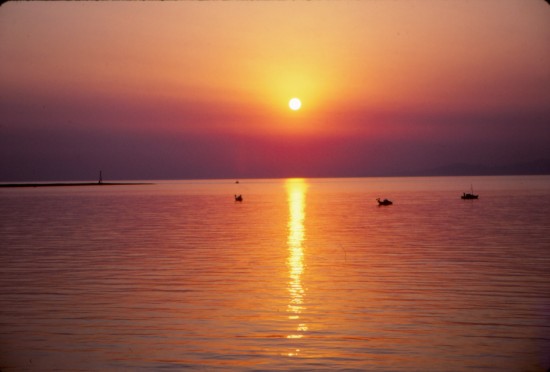
The plunging sun viewed from the Rotonda at dusk
At twilight, we head out to Palaiopolis once more to gaze at the Sanctuary
at sunset. The columns of the Hieron and stones of the Rotonda appear
more radiant and mysterious in the fading light. Standing motionless,
we watch the darkening scene. It is a moment of total serenity. We feel
connected to the site, somehow more alive and aware of what is important
in life. As if we had witnessed the rituals, the great gods have imparted
some of their ancient wisdom to us and we are filled with renewed purpose.
I suddenly realize that our journey to Samothrace is actually a pilgrimage,
a chance to glimpse a world where legends and traditions endure, immune
to the passage of time. It has taken many years and more than two dozen
trips to Greece to finally get here, but we couldn't be happier.
As our ferry departs for Alexandroupolis the next morning, clutching my goat bell, I offer up a silent prayer to the gods: May Nike return one day to her rightful home where the wind still blows and the Aegean salt burns.
